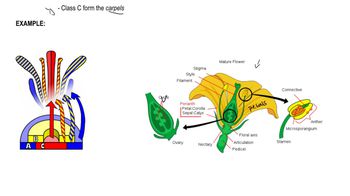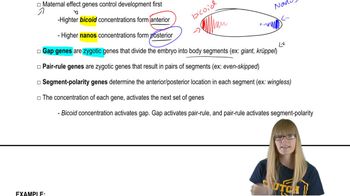Table of contents
- 1. Introduction to Genetics51m
- 2. Mendel's Laws of Inheritance3h 37m
- 3. Extensions to Mendelian Inheritance2h 41m
- 4. Genetic Mapping and Linkage2h 28m
- 5. Genetics of Bacteria and Viruses1h 21m
- 6. Chromosomal Variation1h 48m
- 7. DNA and Chromosome Structure56m
- 8. DNA Replication1h 10m
- 9. Mitosis and Meiosis1h 34m
- 10. Transcription1h 0m
- 11. Translation58m
- 12. Gene Regulation in Prokaryotes1h 19m
- 13. Gene Regulation in Eukaryotes44m
- 14. Genetic Control of Development44m
- 15. Genomes and Genomics1h 50m
- 16. Transposable Elements47m
- 17. Mutation, Repair, and Recombination1h 6m
- 18. Molecular Genetic Tools19m
- 19. Cancer Genetics29m
- 20. Quantitative Genetics1h 26m
- 21. Population Genetics50m
- 22. Evolutionary Genetics29m
14. Genetic Control of Development
Developmental Patterning Genes
Problem 26b
Textbook Question
In Drosophila, loss-of-function Ultrabithorax mutations result in the posterior thoracic segments differentiating into body parts with an identity normally found in the anterior thoracic segments. When the Ultrabithorax gene was cloned, it was shown to encode a transcription factor and to be expressed only in the posterior region of the thorax. Thus, Ultrabithorax acts to specify the identity of the posterior thoracic segments. Similar genes were soon discovered in other animals, including mice and humans. You have found that mice possess two closely related genes, Hoxa7 and Hoxb4, which are orthologs (see Genetic Analysis 14.2 for definition) of Ultrabithorax. You wish to know whether the two mouse genes act to specify the identity of body segments in mice.
How will you determine whether the mouse genes have redundant functions?
 Verified step by step guidance
Verified step by step guidance1
<span>Step 1: Understand the concept of redundancy in genetics. Redundant genes are those that can compensate for each other's function. If one gene is knocked out or mutated, the other can still perform the necessary function, preventing a phenotypic change.</span>
<span>Step 2: Design a genetic experiment to test redundancy. Create knockout mice for each gene separately (Hoxa7 and Hoxb4) and observe any phenotypic changes. If no changes are observed, it suggests redundancy.</span>
<span>Step 3: Create double knockout mice, where both Hoxa7 and Hoxb4 are inactivated. Observe the phenotypic changes in these mice. If significant changes occur, it indicates that the genes have redundant functions, as the loss of both is required to see an effect.</span>
<span>Step 4: Analyze the phenotypic changes in the double knockout mice. Compare these changes to the normal phenotype to determine the specific roles of Hoxa7 and Hoxb4 in segment identity specification.</span>
<span>Step 5: Use molecular techniques, such as in situ hybridization or reporter assays, to study the expression patterns of Hoxa7 and Hoxb4 in mouse embryos. This can provide insights into their roles and potential redundancy in segment identity specification.</span>
Recommended similar problem, with video answer:
 Verified Solution
Verified SolutionThis video solution was recommended by our tutors as helpful for the problem above
Video duration:
2mPlay a video:
Was this helpful?
Key Concepts
Here are the essential concepts you must grasp in order to answer the question correctly.
Hox Genes
Hox genes are a group of related genes that determine the body plan and segment identity during embryonic development in animals. They encode transcription factors that regulate the expression of other genes, influencing the formation of structures in specific body regions. In Drosophila, the Ultrabithorax gene is a well-studied example of a Hox gene, and similar genes in mice, such as Hoxa7 and Hoxb4, play analogous roles in segment identity.
Recommended video:
Guided course

Plant HOX genes
Orthologs
Orthologs are genes in different species that evolved from a common ancestral gene through speciation. They typically retain similar functions across species, making them crucial for comparative genetics. In this context, Hoxa7 and Hoxb4 in mice are orthologs of the Ultrabithorax gene in Drosophila, suggesting that they may have similar roles in specifying body segment identity in mice.
Recommended video:
Guided course

Overview
Gene Redundancy
Gene redundancy occurs when two or more genes perform similar functions, allowing for compensation if one gene is mutated or lost. This phenomenon can complicate the determination of gene function, as the effects of a single gene knockout may be masked by the activity of redundant genes. To assess whether Hoxa7 and Hoxb4 have redundant functions, experiments such as gene knockout studies or double mutants can be employed to observe phenotypic changes in segment identity.
Recommended video:
Guided course

Mapping Genes

 11:19m
11:19mWatch next
Master Segmentation Genes with a bite sized video explanation from Kylia Goodner
Start learningRelated Videos
Related Practice


